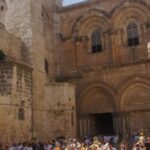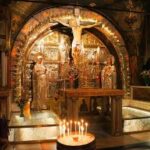August 1, 2012
From the beginning to the end? The alpha and omega of our trip to Israel
We spent two days in Israel, which. for a boat trip, is a long time; of course, it barely scratched the surface.

 Most of the time was spent following the steps of Jesus, which accounts for the alpha and the omega (the first and last letters of the Greek alphabet) in the heading. We got off the ship in Haifa, and went to Galilee, then stayed on the west bank until Jerusalem, then went to Bethlehem. Thus, we saw where Christ was born (Church of the Nativity in
Most of the time was spent following the steps of Jesus, which accounts for the alpha and the omega (the first and last letters of the Greek alphabet) in the heading. We got off the ship in Haifa, and went to Galilee, then stayed on the west bank until Jerusalem, then went to Bethlehem. Thus, we saw where Christ was born (Church of the Nativity in 
 Bethlehem, in an area under Palestinian administration), where he grew up in Nazareth (and where Mary learned she was to bear Jesus–Annunciation), where he preached (Mount of Beatitudes), where he was betrayed, and where he was crucified (the Church
Bethlehem, in an area under Palestinian administration), where he grew up in Nazareth (and where Mary learned she was to bear Jesus–Annunciation), where he preached (Mount of Beatitudes), where he was betrayed, and where he was crucified (the Church 
 of the Sepulcher, and the Via Dolorosa). I’ll have another comment, but one of the most interesting places to me was the Mount of Beatitudes, where our guide suggested Christianity began because Christ drew a crowd of 5000 who followed his preaching for the first time.
of the Sepulcher, and the Via Dolorosa). I’ll have another comment, but one of the most interesting places to me was the Mount of Beatitudes, where our guide suggested Christianity began because Christ drew a crowd of 5000 who followed his preaching for the first time.

Because of the importance of Jerusalem (especially) to Judaism, and its role as the third Holy city of Islam, both their religious sites made our itinerary,  too. The Wailing Wall—the remnant of the Temple area where the two great synagogues of antiquity stood—featured an evening visit during which Orthodox Jews were, ironically, mourning the destruction of both temples (the 9th day of the 9th month), as well as one during the day. As mosques point to Mecca, synagogues point to Jerusalem, and the synagogues within Jerusalem point to the Wailing Wall. Of course, since 1967 and the end of the 6 day war, all of Jerusalem is part of Israel, and the democratic/theocracy of Orthodox Jews who run the country (more or less) have stamped some of the laws—for example, our hotel had a “Sabbath elevator;” when I asked what that was, I was told it was an elevator that automatically stopped at every floor, without anyone indicating a floor, since pushing it was “work,” which is forbidden on the Sabbath for Orthodox Jews. We also stopped in a Kibbutz, which dated from the late 1930s, for a kosher meal; since we had meat dishes (the farm raises cows), we had a flavored ice desert, not ice cream.
too. The Wailing Wall—the remnant of the Temple area where the two great synagogues of antiquity stood—featured an evening visit during which Orthodox Jews were, ironically, mourning the destruction of both temples (the 9th day of the 9th month), as well as one during the day. As mosques point to Mecca, synagogues point to Jerusalem, and the synagogues within Jerusalem point to the Wailing Wall. Of course, since 1967 and the end of the 6 day war, all of Jerusalem is part of Israel, and the democratic/theocracy of Orthodox Jews who run the country (more or less) have stamped some of the laws—for example, our hotel had a “Sabbath elevator;” when I asked what that was, I was told it was an elevator that automatically stopped at every floor, without anyone indicating a floor, since pushing it was “work,” which is forbidden on the Sabbath for Orthodox Jews. We also stopped in a Kibbutz, which dated from the late 1930s, for a kosher meal; since we had meat dishes (the farm raises cows), we had a flavored ice desert, not ice cream.
 The main Muslim site is the Church of the Rock, sacred to Muslims because that’s where Mohammed was supposed to have ascended to Heaven (and to Jews because it is where God tested Abraham by asking him to sacrifice Isaac). It is pretty much off limits to tourists, however; we were told that you have to recite the Koran to gain admittance. For many years (really until the British mandate over Palestine after World War I), Jerusalem was under Muslim rule after the fall of the Byzantine empire. The Kingdom of Jerusalem lasted about 200 years after the first crusade, rebuilding many of the churches the Muslims destroyed, but the Muslim reconquest again turned many of the churches into mosques, or destroyed them again. Hence, many of the churches on sacred sites are fairly recent constructions, though many include remnants of those built by Empress Helena (Constantine’s mother who helped him decide on the conversion of the Empire into a Christian state), and those of the crusaders.
The main Muslim site is the Church of the Rock, sacred to Muslims because that’s where Mohammed was supposed to have ascended to Heaven (and to Jews because it is where God tested Abraham by asking him to sacrifice Isaac). It is pretty much off limits to tourists, however; we were told that you have to recite the Koran to gain admittance. For many years (really until the British mandate over Palestine after World War I), Jerusalem was under Muslim rule after the fall of the Byzantine empire. The Kingdom of Jerusalem lasted about 200 years after the first crusade, rebuilding many of the churches the Muslims destroyed, but the Muslim reconquest again turned many of the churches into mosques, or destroyed them again. Hence, many of the churches on sacred sites are fairly recent constructions, though many include remnants of those built by Empress Helena (Constantine’s mother who helped him decide on the conversion of the Empire into a Christian state), and those of the crusaders.
I was a little surprised at the nature of old Jerusalem, a city of 750,000, like Israel itself, roughly 80% Jewish. A wall built by the Ottoman emperor Suleiman the Magnificent surrounds it, which you might have seen on the news because Mr. Romney was here Walking in the old city, one goes from quarters to quarters—there’s an Armenian quarter (Armenia was the first Christian country), a Muslim quarter, and a Jewish quarter—along with ruins from the Romans, and even King David, who founded Jerusalem around 1000 BC. There was some pretty neat shopping—and it says
Israel itself, roughly 80% Jewish. A wall built by the Ottoman emperor Suleiman the Magnificent surrounds it, which you might have seen on the news because Mr. Romney was here Walking in the old city, one goes from quarters to quarters—there’s an Armenian quarter (Armenia was the first Christian country), a Muslim quarter, and a Jewish quarter—along with ruins from the Romans, and even King David, who founded Jerusalem around 1000 BC. There was some pretty neat shopping—and it says something about the tourist mix that there were Sox, Cubs and Bulls t-shirts in English—and Hebrew. At 3000 feet above the Jordan Valley (which is around 1000 feet below sea level), it was a lot cooler–thankfully.
something about the tourist mix that there were Sox, Cubs and Bulls t-shirts in English—and Hebrew. At 3000 feet above the Jordan Valley (which is around 1000 feet below sea level), it was a lot cooler–thankfully.
As for the Christian holy sites, their administration reflects, I think, the divisions that sometimes plague Christianity itself—
 there are usually three groups—Catholics (usually the Franciscans), the Greek Orthodox (you can easily tell their part of the church by the icons), and the Armenians, but sometimes others such as the Coptic Christians (of Egypt), Assyrians, etc. There’s a ladder in the Church of the Holy Sepulcher, for example, that the Armenians used until the 1870s to enter the church from an adjacent building, until a truce allowed them to use the front door
there are usually three groups—Catholics (usually the Franciscans), the Greek Orthodox (you can easily tell their part of the church by the icons), and the Armenians, but sometimes others such as the Coptic Christians (of Egypt), Assyrians, etc. There’s a ladder in the Church of the Holy Sepulcher, for example, that the Armenians used until the 1870s to enter the church from an adjacent building, until a truce allowed them to use the front door  like everyone else. The ladder has remained in place, however, because the three groups haven’t been able to decide who should move it. The Muslim-other position can be perhaps defined by their closing of the Dome of the Rock to nonbelievers; and the Muslim-Jewish position was suggested by our guide from the Jewish side, when he pointed out a synagogue in the old city was destroyed when the Muslims took the city; when the Jews returned, they did not destroy the mosque, but rebuilt the temple next door. And across from the Church of the Holy Sepulcher
like everyone else. The ladder has remained in place, however, because the three groups haven’t been able to decide who should move it. The Muslim-other position can be perhaps defined by their closing of the Dome of the Rock to nonbelievers; and the Muslim-Jewish position was suggested by our guide from the Jewish side, when he pointed out a synagogue in the old city was destroyed when the Muslims took the city; when the Jews returned, they did not destroy the mosque, but rebuilt the temple next door. And across from the Church of the Holy Sepulcher  (through the checkpoint to get into Palestinian authority land) there’s not only a new mosque, but a poster of an armed Palestinian warrior with the challenge to restore and reunite….wouldn’t it be wonderful if there were peace among the religions in the Holy Land, as a step toward peace on Earth?
(through the checkpoint to get into Palestinian authority land) there’s not only a new mosque, but a poster of an armed Palestinian warrior with the challenge to restore and reunite….wouldn’t it be wonderful if there were peace among the religions in the Holy Land, as a step toward peace on Earth?